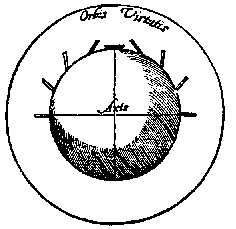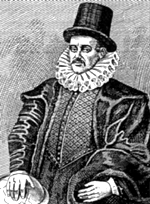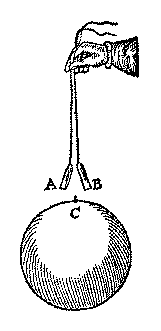|
[an error occurred while processing this directive]
Teaching about the Earth's Magnetism |
Go to Part 1
Go to Part 3
Over the surface of the terrella he moved a magnetic compass. More accurately--since the compass had to stay horizontal--he moved the terrella, placing the compass next to various points on it.
When the compass was level with the surface of the terrella, the needle always pointed to the magnetic north pole of the terrella.
The picture here shows what happened when the compass was perpendicular to the terrella--the poles are on the left and right, the equator on top, and the needle in general slants down, just the way Robert Norman observed. At the poles, it points straight down, on the equator it is horizontal. This experiment convinced him that the directionality of the compass was caused by the Earth itself being a great magnet.
Supposedly, he demonstrated his terrella to Queen Elizabeth--at least, a painting of such a demonstration exists.
If you lived in London in 1600, you could have purchased "De Magnete" for seven shillings and sixpence. To read it, of course, you would have to know Latin, the language of science in 1600. You might have had the rare privilege of attending first runs of Shakespeare's plays in the "Globe" theatre--sitting in the balcony if you could afford it, standing in front of the stage if not. However, you might have had to weigh this pleasure against the peril of bubonic plague, which usually spread in the city during summer months.
This web site tells the story of Gilbert and his book--with glimpses of London in 1600, and with studies of magnetism before Gilbert. It then recounts the later history of the Earth's magnetism, including...
Magnetism from Gilbert to 1820
The Dynamo Process
And some questions you will find on the web site, but won't be discussed here:
Here only some ideas can be outlined, but you will find much more material on the web site, and many more stories.
Why is the Earth magnetic? Gilbert thought magnetism was an inherent property of the Earth, permanent magnetism like that of lodestones.
But a few decades later it turned out that the direction of the compass needle slowly varied: a permanent magnet would not do so. Halley--the astronomer who predicted the return of the comet now named after him--came up with an ingenious explanation. The inside of the Earth contained spheres within spheres, each magnetized with its own poles, and the field changed because each sphere slowly rotated in relation to the others.
We now know the Earth is too hot to be magnetic. As Gilbert discovered, magnetized iron lost its power when it was made red-hot-- although when it cooled again, it "captured" the surrounding magnetic field of the Earth, and became weakly magnetized in that direction. (Please remember that, we will come back to it! ) Although the core of the Earth is probably mostly iron, it is hot enough for that iron to be molten, far too hot for permanent magnetism.
In 1908 the astronomer George Ellery Hale--founder of the great observatories on Mt. Wilson and Palomar in California--analyzed the light of sunspots, and found evidence that they were all strongly magnetized. The Sun is even hotter than the Earth's core--it is gas, hot enough to conduct electricity. Whatever made sunspots magnetic could not be permanent magnetism. That only left electric currents, as Oersted had shown.
Author and Curator: Dr. David P. SternThe Terrella

The Great Magnet, the Earth
by David P. Stern
Commemorating the 400th anniversary of "De Magnete" by William Gilbert of Colchester
(Best viewed in font #14,
but print in #10 or #12)

William Gilbert
In 1600, four hundred years ago William Gilbert, later physician to Queen Elizabeth I of England, published his great study of magnetism, "De Magnete"--"On the Magnet". It gave the first rational explanation to the mysterious ability of the compass needle to point north-south: the Earth itself was magnetic. "De Magnete" opened the era of modern physics and astronomy and started a century marked by the great achievements of Galileo, Kepler, Newton and others.
Table of Contents
The Gilbert anniversary provided the original motivation for assembling the a site, and the first 5 sections after the home page are related to this and include two reviews of his book. You can still buy from Dover books, for $14.00, a paperback copy of an English translation first published in 1893. All the links on the list below are active.
A review of "De Magnete"
Another review of "De Magnete"
(By Stuart Malin and David Barraclough
in Eos of 23 May, 2000).
More about "De Magnete"
Performing Gilbert's Experiment on Induced Magnetism
What was known in Gilbert's Time
London in 1600
Oersted and Ampere link Electricity to Magnetism
The Lodestone
Gauss and the Global Magnetic Field
The Sun's magnetic cycle
The Self-Sustaining Dynamo in the Earth's Core
About Electronic Magnetometers and about Smoking
Magnetic Reversals and Moving Continents
The Magnetosphere
Planetary MagnetismOf Special Interest to Science Teachers
Note to Science Teachers
Teaching Geomagnetism in an Earth Sciences Class
, a short article submitted to "The Physics Teacher" with suggestions on using this material in schools.
Teaching about the Earth's Magnetism in Earth Sciences, a one-hour illustrated talk given by the author 18 November 2000 before the regional meeting of the National Association of Science teachers (NSTA). For faster loading, this document is divided into 3 parts.
Go to Part 1
Go to Part 2 (The file you have open now!)
Go to Part 3
Geomagnetism since Gilbert
The rest of the site contains a great deal of more recent developments--even about the Sun, on magnetism in space and on the magnetic fields of planets, some of them much stronger than the Earth's. You might enjoy, for instance, the section "About Electronic Magnetometers and about Smoking. " For and Earth Sciences class, some of the basic questions are:
(He also thought it was related to the rotation of the Earth around its axis. At that time the church still maintained the Earth was the center of the universe and everything revolved around it. In the same year 1600 Giordano Bruno was burned at the stake, in part because he claimed the Earth rotated, and some copies of Gilbert's book had the pages on the Earth's rotation torn out or defaced. Galileo--who praised the book--got his copy as a gift from a "philosopher who wanted to rid his library of its contagion.")
Go to Part 3Back to the Master List
Mail to Dr.Stern: earthmag("at" symbol)phy6.org
Last updated 25 November 2001
Re-formatted 9-27-2004


